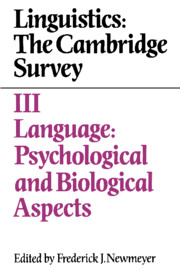Book contents
- Frontmatter
- Contents
- Contributors
- Preface
- 1 Psycholinguistics: an overview
- 2 Language and cognition
- 3 Processes in language production
- 4 Language perception
- 5 The mental lexicon
- 6 Where learning begins: initial representations for language learning
- 7 Second language acquisition
- 8 Neurolinguistics: an overview of language–brain relations in aphasia
- 9 The biological basis for language
- 10 Linguistics and speech–language pathology
- 11 The evolution of human communicative behavior
- 12 Linguistics and animal communication
- Index of names
- Index of subjects
- Contents of Volumes I, II, and IV
Preface
Published online by Cambridge University Press: 03 February 2010
- Frontmatter
- Contents
- Contributors
- Preface
- 1 Psycholinguistics: an overview
- 2 Language and cognition
- 3 Processes in language production
- 4 Language perception
- 5 The mental lexicon
- 6 Where learning begins: initial representations for language learning
- 7 Second language acquisition
- 8 Neurolinguistics: an overview of language–brain relations in aphasia
- 9 The biological basis for language
- 10 Linguistics and speech–language pathology
- 11 The evolution of human communicative behavior
- 12 Linguistics and animal communication
- Index of names
- Index of subjects
- Contents of Volumes I, II, and IV
Summary
Language: psychological and biological aspects is the third volume of the four-volume series, Linguistics: the Cambridge survey. The first two volumes, Linguistic theory: foundations and Linguistic theory: extensions and implications, review the state of research on grammatical competence per se, both from the point of view of its structural properties and from the evidence from diverse areas of investigation that support the idea that the principles of generative grammer provide an adequate characterization of the human linguistic faculty. The focus of this volume is not the theory of grammar per se, but rather the broader psychological and biological aspects of language, including such topics as the role of language in cognition, its processing by speakers and hearers, its acquisition by first and second language learners, its representation in the brain, and its phylogenetic evolution. Roughly speaking, then, it covers the subfields of ‘psycholinguistics’ and ‘neurolinguistics’. The fourth volume, Language: the socio-cultural context, treats sociolinguistics and allied subfields, such as ethnography of speaking, and conversation and discourse analysis.
In the first chapter of this volume, Michael K. Tanenhaus presents an overview of the field of psycholinguistics, giving a deft historical account not only of its achievements, but also of the tensions that have existed over the past generation between behavioral, cognition-based, and competence-based models of language. Tanenhaus reviews the effect on the field that the surge of interest in artificial intelligence has had (and will continue to have), and explains why psycholinguists are, on the whole, more receptive now to the rules and representations proposed by grammatical theorists than they were a decade ago.
- Type
- Chapter
- Information
- Linguistics: The Cambridge Survey , pp. vii - xPublisher: Cambridge University PressPrint publication year: 1988

